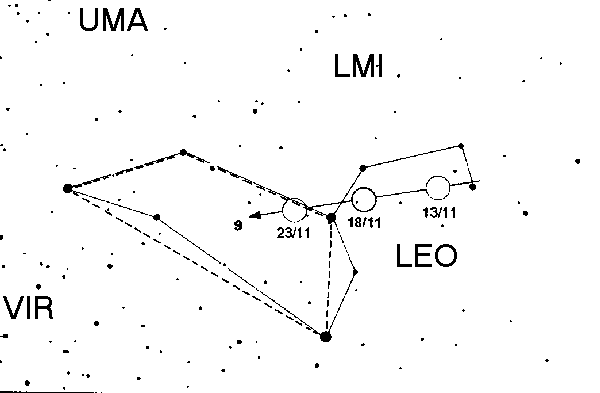 Technical equipment consisting of camera batteries and a videocamera in use at station Alcudia during
the november 1995 DMS Leonid / alfa Monocerotid observing campaign in Andalacia, Spain.
Team-members of station Alcudia: Marco Langbroek, Koen Miskotte, Robert Haas,
Jos Nijland and Casper ter Kuile
Technical equipment consisting of camera batteries and a videocamera in use at station Alcudia during
the november 1995 DMS Leonid / alfa Monocerotid observing campaign in Andalacia, Spain.
Team-members of station Alcudia: Marco Langbroek, Koen Miskotte, Robert Haas,
Jos Nijland and Casper ter Kuile
In order to observe the anticipated outbursts of the Leonid and alpha Monocerotid streams in November
1995, the Dutch Meteor Society has mounted an observational expedition to the climatologically more
favourable area around the city of Granada in Southeastern Spain. During the period of November 14
until November 23, 21 DMS Observers will establish three temporary meteor stations at the small
villages of Almedinilla, Zaffaraya and Alcudia, about 80 kilometers distant of each other, in a geometric
pattern favourable for multistation photography and videography. Full multi-camera photographic
equipment (Canon) covering the whole sky will be employed on each site, as well as image intensified
video equipment. In addition, spectrographic equipment will be employed from Almedinilla.
Goal of the expedition is to gather high precision photographic orbits from both streams as well as
detailed visual observations of the outbursts. Similar activities are planned for future Leonid returns.
Spanish observers of SMS will cooperate in the project and establish a fourth station, which will be
supplied with photographic equipment by DMS. Peter Jenniskens (DMS and NASA/Ames Research
Center) plans a shadow expedition to Hawaii in cooperation with American observers of the Meteor
Group Hawaii. In this way, we hope to be able to construct a good activity profile of the 1995 Leonid
event.

The logo of the DMS Leonids and alfa Monocerotids expedition to southern Spain in november 1995.
Design and production: Robert Haas
The DMS expedition to Andalusia, Spain, has been made possible thanks to financial and material
support by the Prins Bernhard Fund, the Kerkhoven-Bosscha fund of Leiden University (dept. of
astronomy), the foundation Physica, Shell Netherlands bv, Honda power equipment, CANON, Delft
Electronic Products, Kodak, Ilford and Op den Kelder Technologie Support, to all of whom we are
greatly indebted.

As expected, a moderate Leonid outburst occured on November 17-18, 1995. Following the predictions
by Jenniskens (Meteoritics March 1996 (in press)), peak rates have been in the order of ZHR ~30
(outburst component only). Deviating from his predictions, peak rates however occured about 0.5
degrees earlier in solar longitude. Instead of the Pacific, Europe got the show.
DMS observers participating in the succesful 1995 Leonid and alpha Monocerotid expedition to
Andalucia, Spain, observed ZHR's near ~35 for the period of 1-6h UT on November 18. Observers who
stayed in the Netherlands obtained similar results. Dr. Jenniskens reports ZHR's near ~18-20 as
observed by his team in California some hours before and after.
This suggests a peak above Europe with maximum rates near ZHR ~40-45 (outburst and annual
component together), and a broad event similar to the 1994 event (though lower in maximum rates) and
the 1961 and 1965 events.

During the enhanced activity, the Leonids were on average evidently much brighter than usual. DMS observers at Alcudia de Guadix report that ~25% of their Leonid meteors was equal to or brighter than magnitude zero. However, no spectacular Leonid fireballs were seen during this night.
 |
 |
Following the prediction by Dr. Jenniskens (WGN June 1995; Astron. Astroph. 295 (1995), 206) a spectacular outburst of the alpha Monocerotid stream has been observed by observers all over Europe on November 22, 1995.
 |
According to preliminary results obtained by DMS observers at Calar Alto Observatory and Czechian
observers at Ondrejov observatory (Spurny and Borovicka, internet communication), peak rates occured
near 1:28 UT with peak ZHR's near ~800-900. The activity profile has been very steep: 15 minutes after
the peak, rates had fallen to ZHR ~75. Radio observations by De Meyere (Belgium: Radio Meteor
Observers Bulletin) confirm the position of the peak.
The outburst was of such a strength that it actually might classify as a small storm.
 |